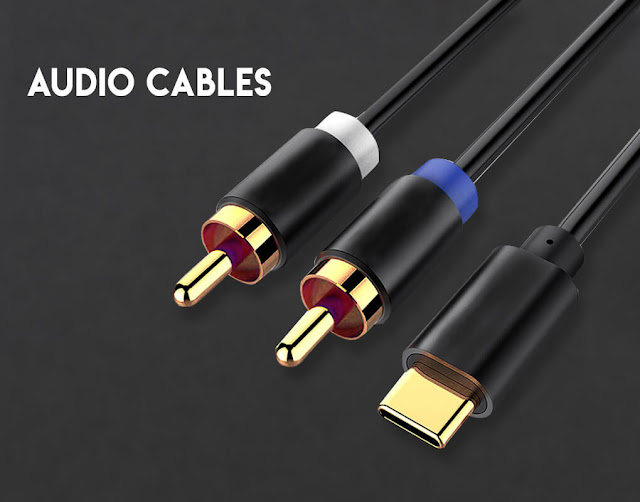(Featured Image by Image by Marvin Ahlers from Pixabay.)
from Pixabay.)
DISCLOSURE: This article is made possible by CableTech MEA – Professional supplier of high-quality equipment for broadcast, audio, and video industries.
– Professional supplier of high-quality equipment for broadcast, audio, and video industries.
You have stepped out to purchase a new audio cable but still confused about what should be the right cable for your high-ended system. You are not a tech geek and do not want to look foolish in front of a salesman, as you do not know the very basics of audio cables.
No worries. Read this article, and you will get enough information, to impress a salesman.
Audio cables are not the most important part of your setup but understanding the different types of audio cables and how they perform with different devices is important. This thing can eliminate the confusion and make it sure for you to get the best possible cable.
For most of us, an audio cable is the simplest thing and there is nothing to worry about while purchasing one.
You come to know the varieties and types of audio cables when you go out to buy one. So, we get to start from the very beginning. Stick in here, do not rush around, and read the entire article.
What are Audio Cables?
“A cable which is used to transfer analog or digital signal produced from the audio speaker or amplifier”. This is the simplest definition of an Audio cable: it is simply the wire which transfers the audio from one component to the other components.
Like when we speak in a mic, the audio cable transmits the signal to be processed, and you can hear that voice in a loudspeaker .
.
Every Audio cable, even if it is properly inserted, produces some noise and distortion. Therefore it is very important to know the kind of cable to use for a specific job.
Where many of us get confused is the division of Balanced and Unbalanced cables. You need to go through some of the basics of it.
Related: Researchers Successfully use Light to Transmit Sound
Unbalanced Cables
I am not going to elaborate the inch and squares of unbalanced cables. I will just give you an idea; what unbalanced cables are.
This cable consists of two wires: a signal wire (sound wire), and a ground wire. The signal wire or sound wire transfers the signal and the ground wire protects this wire from external interferences like lights, TV, radio transforms.
The thing which makes this cable unbalanced (cable) is that it passes the signal or sound without manipulating.
Leaving the audio untouched, or not manipulating, makes the stuff simpler, but sometimes the audio can become distorted.
Examples of Unbalanced Cables
RCA connector, Standard TS cable connector are some examples of unbalanced cables.
Balanced Cables
In this cable, there are three wires, two used for passing the signals or sounds and one is a ground wire to protect the other two wires from distortion or external electronic distortions.
Examples of Balanced Cables
TRS cable connectors, XLR cables connectors are examples of balanced cables.
Different Types of Audio Cables
The purpose of a cable is to pass the electrical signal from one device to the other connected device or component.
Ultimately, you are searching for the cables which are flexible, durable and which has the ability to pass the voice in better quality.
Ultimately, you are searching for the cables which are flexible, durable and which has the ability to pass the voice in better quality.
There are four types of cables:
1. Instrument cables
This type of cable is used to direct connection of an instrument like you connect your guitar, bass, keyboard and another instrument to the amplifier
2. Patch cables
These are the type of cables used in recording setups.
These cables connect different components together, and they are used for a short length.
3. Microphone cables
To connect a microphone to a sound system we use Microphone cables. These are the widely used type of cable.
You use your headphone; connect your headphone jack into the laptop or computer port to listen to the songs or to watch the movies.
4. Speaker Cables
This is an unbalanced cable; these cables mostly are bigger wires, because they carry much higher voltage.
Advice That You Must Listen Buying Audio Cables
- Length of the cable
Most cables come in standard lengths; you have no need to be precisely related to the length before going to purchase that.
But, it would be ideal for you to measure the cable before buying.
It is very easy to figure out, take a piece of string and run it from one of the components you want to connect to the other.
And get an idea about the length of the cable, as it can eliminate the fuss of buying a short cable.
Get an idea of the length of the cable, as it can eliminate the fuss of buying a short cable.
- Correct format
The second most important thing you need to do before purchasing an audio cable, choose the correct format.
You must know which format you want to get, a stereo, analog surround sound or digital surround sound cable.
or digital surround sound cable.
Stereo is the most basic and consist of only two cables.
If you want to get a simpler and less expensive cable you can go for it.
All sound systems have a code written in the form of a number, a period and then another number.
The first number indicates the number of channels ; the second number shows the low-frequency.
; the second number shows the low-frequency.
All sound systems have a code written in the form of a number, a period and then another number. The first number indicates the number of channels; the second number shows the low-frequency.
So, before stepping out to purchase a cable decide which type of cable you want to buy and from where you are going to buy it.
CableTech MEA is the best audio cables supplier company that provides high-quality audio cables in the Middle East. Buy audio cables
cables supplier company that provides high-quality audio cables in the Middle East. Buy audio cables from CableTech outlets or through CableTech online store.
from CableTech outlets or through CableTech online store.
Match the quality of the cable to Quality of your System
You spend thousands of dollars on CD players, Cable television, and stereos, but you are not pleased with the audio quality of your system.
You will remain unhappy with the quality of your cables unless you choose digital cables.
- Digital cables transmit more signals than any of the other audio cables.
- Digital cables produce a clear signal, resulting in clear audios.
In fact, you need to choose an audio cable made of high-quality material.
The oxygen-free copper center surrounded by the braided copper and foil is the best material, as the foil helps to remove the buzz from the cable.
You must go for this property centered cable. Also, search for a connector that has high-pressure contact.
Low-quality audio cables can ruin your experience of listening to a song on the high-ended system, which you have set up after spending the whopping amount of money.
- Right speaker wire
When you go out to buy a speaker wire, you need to consider these factors:
1. The gauge of the wire
- Between (80,200) the user should go for 14-gauge wire
- For 200 feet its gauge of the wire should be 12
- You should prefer lower gauge wire
2. Ends type
There five different types of ends wire:
- Stripped bare wire; Pin connector
- Spade plugs (For secure connections)
- Banana Plugs (Those who move their stereo often use this)
- Spring plugs (Best for running the wire through the wall)
- These are some steps you need to consider while purchasing speaker wire for your system
Most of the people find buying audio cable very confusing; it is not, in fact. You just need to know which type of cable you want to get.
Knowing the correct format of the cable, and the quality of the cable is the most important.
In the end, you only have to choose the audio cable – according to what we have explained – that suits your needs.


